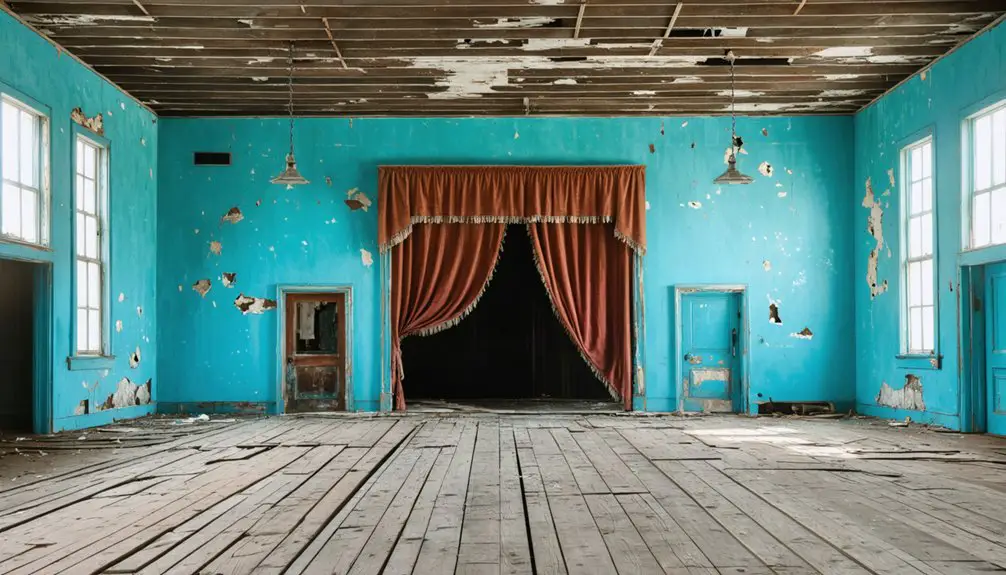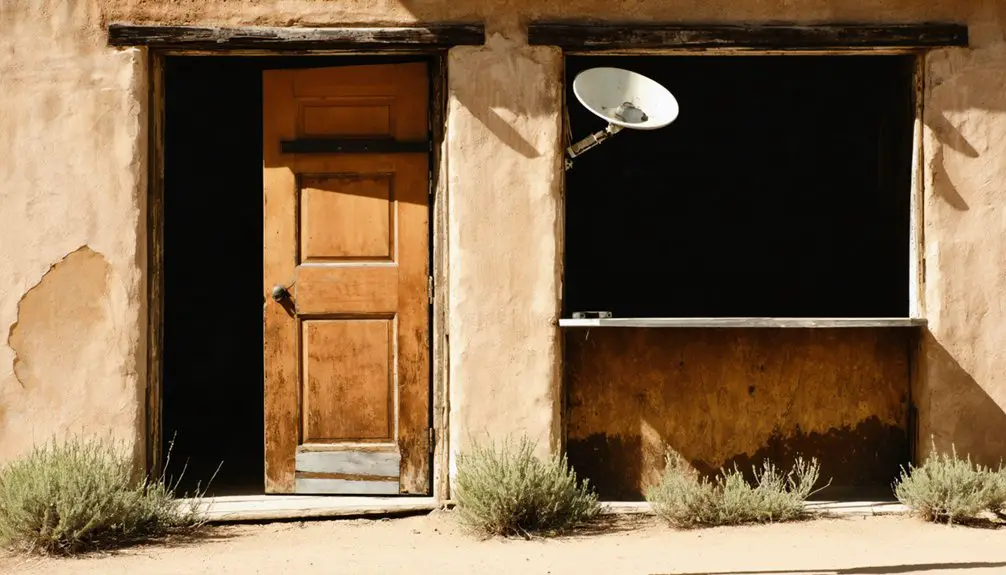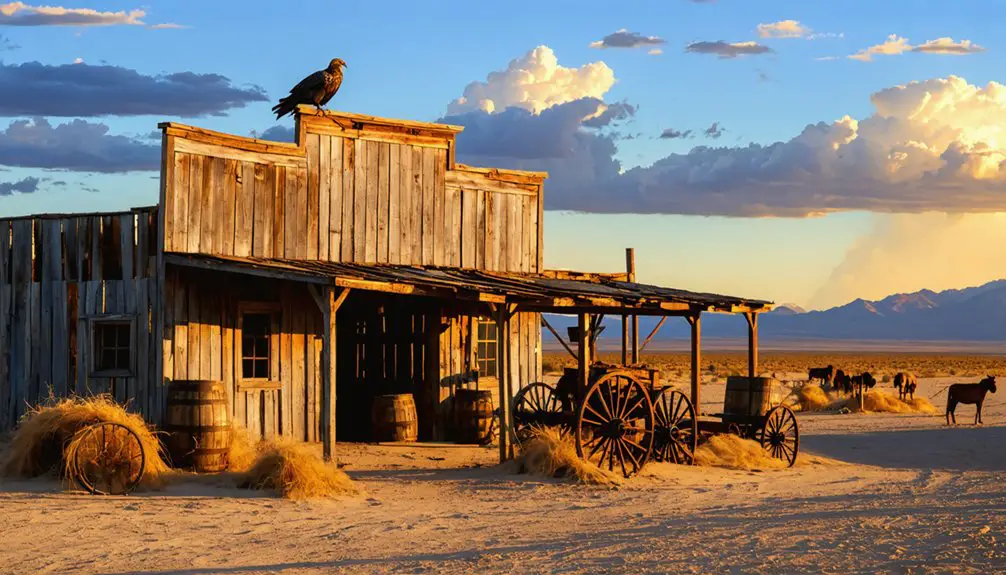You’ll find La Belle ghost town in New Mexico’s Keystone Mining District, where gold’s discovery in 1866 sparked a mining camp that officially formed in 1894. Named after Belle Dixon, the town quickly grew to 700 residents with over 70 buildings, including the grand Southern Hotel. By 1901, the post office closed as mining profits dwindled. Today, scattered ruins, mining shafts, and the modern La Belle Lodge mark where prospectors once chased their golden dreams.
Key Takeaways
- La Belle was established in 1894 as a mining town in New Mexico’s Keystone Mining District after gold discoveries in 1866.
- At its peak in 1895, the town boasted 600-700 residents and over 70 buildings, including the prominent 80-room Southern Hotel.
- The town featured a vibrant social scene with saloons, hotels, and regular community events like boxing matches and dances.
- Notable outlaw Black Jack Ketchum frequented the area, contributing to the town’s Wild West reputation.
- By 1901, La Belle declined significantly, with only scattered ruins and mining remnants visible today near the modern La Belle Lodge.
A Gold Rush Town Is Born
While prospectors first discovered minerals near La Belle in the summer of 1866, the town itself wasn’t officially established until 1894 as a mining camp in New Mexico’s Keystone Mining District. Named after Belle Dixon, wife of an original investor, the town quickly attracted fortune seekers to its rugged mountain location eight miles northeast of Red River. The name “La Belle” carried special meaning as the French term for the beautiful one.
The economic impacts were immediate and dramatic. Within months, miners had staked numerous claims with colorful names like Wonder, Colorado, and Gold Bug. Mining techniques varied as prospectors worked claims on private land owned by the Freehold Land and Emigration Co. At its peak, the bustling town boasted over 70 buildings, including hotels, saloons, and other businesses serving the mining community.
The Rise of a Mining Community
You’ll find La Belle’s early settlers drawn by the promise of gold in the 1890s, as mining operations attracted hundreds of prospectors and entrepreneurs to stake their claims in the Keystone Mining District.
The population swelled rapidly to reach 600-700 residents by 1895, transforming the landscape with roughly 80 buildings to serve the growing community.
The town’s social fabric centered around prominent establishments like the four-story Southern Hotel, which boasted 80 rooms and stood as a symbol of La Belle’s rising prosperity. The LaBelle Cresset newspaper brought news and information to residents from 1894 to 1898.
Mining Draws Early Settlers
Following the initial gold discoveries in 1866, La Belle quickly evolved from untamed wilderness into a bustling mining settlement within the Keystone Mining District.
With basic mining techniques and prospecting tools in hand, you’d have found early claim holders working properties like the Wonder and Colorado mines, searching for that elusive gold strike.
The region’s potential drew the attention of both individual prospectors and the Dutch-owned Costilla Estate, though claim fees imposed by the U.S. Freehold Land and Emigration Company proved challenging for many miners.
You’d have witnessed some settlers cleverly establishing claims on nearby government lands, leading to the creation of Anchor town.
Soon, the once-empty landscape transformed as sawmills, cabins, and stores emerged to support the growing community of fortune seekers.
Rapid Population Growth Unfolds
The establishment of La Belle as a mining camp on August 28, 1894, marked the beginning of explosive growth in the Keystone Mining District.
You’d have witnessed remarkable settlement patterns as the population dynamics shifted dramatically – within four months, roughly 80 buildings dotted the landscape, including saloons, hotels, and essential businesses.
Like many towns across the territory that would become the 47th state in 1912, La Belle emerged during a period of rapid Western expansion and resource exploitation. Similar to the rush that created Pinos Altos, prospectors flocked to the area seeking their fortunes in precious metals.
Hotels Shape Social Life
While miners flocked to La Belle’s promising ore deposits, three prominent hotels emerged as the social heartbeat of the burgeoning town. The Southern Hotel, a four-story marvel with 80 rooms, showcased the town’s hotel significance through its $30,000 investment – equivalent to $1.1 million today.
You’d find these hotels weren’t just places to rest. They transformed into vibrant hubs where community gatherings flourished. The spaces hosted boxing matches, horse races, and baseball games, while a social club organized lively debates and dances at venues like the Nadock Hotel.
The establishments united diverse groups, from miners to businessmen, creating bonds in an otherwise transient environment. Even as mining prospects dimmed, these social centers maintained La Belle’s spirit, offering residents a taste of civilization amid the rugged frontier.
Daily Life in La Belle’s Streets
You’d find La Belle’s streets bustling with miners frequenting the town’s hotels, saloons, and stores, where the regular dances at venues like the Nadock Hotel provided entertainment and social connections.
Local businesses, including a mercantile, butcher shop, and restaurant, served the daily needs of the town’s 600 residents during its peak years from 1894 to 1901.
While notorious outlaws like Black Jack Ketchum often visited the establishments, the remote mining community maintained a semblance of order through its mix of permanent families and transient workers.
Entertainment and Social Scene
During La Belle’s peak years in the 1890s, social life centered around the town’s bustling saloons and the prominent Nadock Hotel, where miners, merchants, and travelers gathered for entertainment and companionship.
You’d find the hotel’s assembly rooms hosting lively dances, with occasional appearances by notorious figures like Black Jack Ketchum and his associates.
The saloons offered popular leisure activities including poker and billiards, while impromptu singing and storytelling sessions filled the evening hours.
The *LaBelle Cresset* newspaper kept residents informed of upcoming social gatherings between 1894 and 1898.
You might’ve caught sight of horse races near town or joined the celebrations that erupted when mail arrived.
These social activities created a vibrant atmosphere where miners, families, and even outlaws mingled, shaping La Belle’s unique frontier character.
Local Shops and Services
The bustling streets of La Belle featured an array of essential services that kept the mining town running.
You’d find local supply stores stocked with mining necessities, from tools to daily provisions. The mercantile store served as your one-stop shop for household goods, while the butcher shop provided fresh meat for the town’s 600+ residents.
For your daily needs, you could visit any of several general merchandise stores scattered throughout La Belle.
You’d handle your mail and stay connected to the outside world at the post office, which operated from 1895 to 1901.
When you needed rest, the Nadock Hotel offered rooms and meals.
Mining support services, including blacksmith shops and claim offices, helped keep your mining operations running smoothly in this remote mountain community.
Law and Public Order
While merchants kept La Belle’s streets bustling with commerce, law enforcement faced constant challenges maintaining order in this remote mining town. Sheriff Edward Farr patrolled the streets until his death in 1899 at the hands of notorious outlaw Black Jack Ketchum, who frequently haunted the area’s social spots.
You’d find three saloons serving as social hubs where miners mingled with outlaws at local dances, particularly at the Nadock Hotel.
Crime trends revealed a pattern of train robberies and murders, though no major gang wars erupted. When serious crimes occurred, trials weren’t held locally – lawbreakers faced justice in regional hubs like Clayton, where Ketchum met his fate at the gallows.
As La Belle’s population dwindled after 1901, law enforcement presence gradually disappeared, leaving the once-bustling streets quiet.
The Southern Hotel: A Symbol of Prosperity
Situated prominently in La Belle’s bustling center, the Southern Hotel emerged as a symbol of the town’s meteoric rise following its 1894 establishment.
As an economic indicator, the four-story structure’s $30,000 construction cost – equivalent to $1.1 million today – demonstrated investors’ confidence in the mining camp’s future.
The architectural significance of this 80-room giant dwarfed its competitors, including the 14-room Exchange Hotel.
With its impressive 80 rooms, the Southern Hotel stood as an architectural titan among La Belle’s more modest lodgings.
Much like the historic Henry Lambert properties, which began as simple saloons before evolving into grand establishments, the Southern Hotel transformed from modest beginnings.
Relocated from nearby Catskill, the Southern Hotel served as a community hub where miners, businessmen, and travelers gathered.
You’d find the building at the heart of local commerce, surrounded by mercantile stores and blacksmith shops.
Like the iconic Fred Harvey Houses, the Southern Hotel became a vital social center, hosting debates, dances, and boxing matches, weaving itself into the social fabric of frontier life.
Outlaws and Entertainment in the Wild West

Beyond the Southern Hotel’s refined atmosphere, La Belle’s Wild West character emerged through its rougher entertainment venues and outlaw presence. You’d find three bustling saloons by late 1894, where miners tried their luck at faro, roulette, and poker. Much like Madam Varnish’s saloon in White Oaks, these establishments became central to the town’s social life.
The outlaw culture peaked in 1899 when authorities captured the notorious Black Jack Ketchum in town.
The saloon life extended beyond mere drinking. You could’ve witnessed the Hagen brothers establishing a red-light district in July 1895, with brothels operating from saloons’ upper floors.
While the town’s jail stood as a symbol of law and order, locals claim it never held inmates. Despite this lawlessness, La Belle maintained cultural connections through its newspaper, the La Belle Cresset, and venues like the Nadock Hotel served as community gathering spots.
When Dreams of Gold Crumbled
Although La Belle’s gold discovery in 1866 sparked dreams of wealth, those hopes wouldn’t materialize until the 1890s when miners first established the camp.
You’d have found a bustling scene by 1894, with 80 buildings and hundreds of fortune-seekers staking their claims in the Keystone Mining District.
Yet the dream quickly began to fade. High fees imposed by private landowners made gold mining less profitable than on nearby government lands. Many disappointed prospectors misidentified fool’s gold pyrite as the real thing.
Despite the town’s impressive growth – including three hotels and the prominent La Belle Cresset newspaper – the precious metal yields couldn’t sustain the community.
By 1901, the post office closed, and the population dwindled.
Today, La Belle stands among New Mexico’s ghost towns, with only scattered mine shafts, prospect pits, and chimney falls marking where determined miners once chased their golden aspirations.
Modern Traces of a Forgotten Era

While most original structures have vanished into time, La Belle’s legacy endures through scattered remnants across the mountainous landscape.
You’ll find numerous mining shafts and prospect pits dotting the forest, silent witnesses to the area’s gold rush fever. La Belle Lodge stands as the sole modern structure, built mid-20th century and modified through the 1980s.
Mining shafts pierce the forested slopes like scars of golden dreams, while La Belle Lodge watches over the mountain’s abandoned memories.
Today’s traces include a cluster of rocks believed to be a fallen chimney, and valley-bottom depressions marking former placer mining sites.
Though La Belle Creek’s name has changed on modern maps, cultural legacies persist through local legends of Black Jack Ketchum’s hidden treasure and the town’s portrayal in contemporary media.
The site’s rich history lives on through the preserved pages of the La Belle Cresset newspaper and stories of the once-bustling Nadock Hotel’s dance halls.
Frequently Asked Questions
What Role Did Native Americans Play in La Belle’s History?
You’ll find native Ute and Jicarilla Apache tribes controlled 100% of La Belle’s mountainous terrain before settlers arrived. Their cultural heritage shaped the region’s development, though no formal Native American treaties existed there.
Were There Any Major Fires or Natural Disasters in La Belle?
You won’t find any documented fire incidents or natural calamities in historical records. Though wooden buildings posed typical fire risks, there’s no evidence of major disasters affecting the town’s structures.
How Did Children Receive Education in La Belle?
You’d find schooling methods centered around a quickly-built schoolhouse where local educators taught multiple grades in one room, focusing on basic reading, writing, and arithmetic for miners’ children.
What Was the Primary Source of Water for La Belle Residents?
You’ll find that wells were likely the primary water source, though specific irrigation methods aren’t documented. Springs may have supplemented water needs, while residents probably collected rainwater in cisterns.
Did Any Famous Actors or Politicians Ever Visit La Belle?
Like tumbleweed drifting through an empty street, you won’t find any Hollywood visits or political intrigue here. Historical records don’t show any famous actors or politicians ever visiting this remote mining town.
References
- https://exhibits.stanford.edu/mining/catalog/zb877tw9174
- https://en.wikipedia.org/wiki/La_Belle
- http://ghosttowns.placesandpics.com/new-mexico/labelle-nm/
- https://www.restlessgeographer.com/n-amer42
- https://westernmininghistory.com/towns/new-mexico/la-belle/
- https://westernmininghistory.com/gallery/538457/historical/towns/
- https://en.wikipedia.org/wiki/New_Mexico
- https://www.newmexico.org/places-to-visit/ghost-towns/
- https://digitalrepository.unm.edu/cgi/viewcontent.cgi?article=1920&context=nmhr
- https://www.youtube.com/watch?v=O_1iT_a-Wzw



